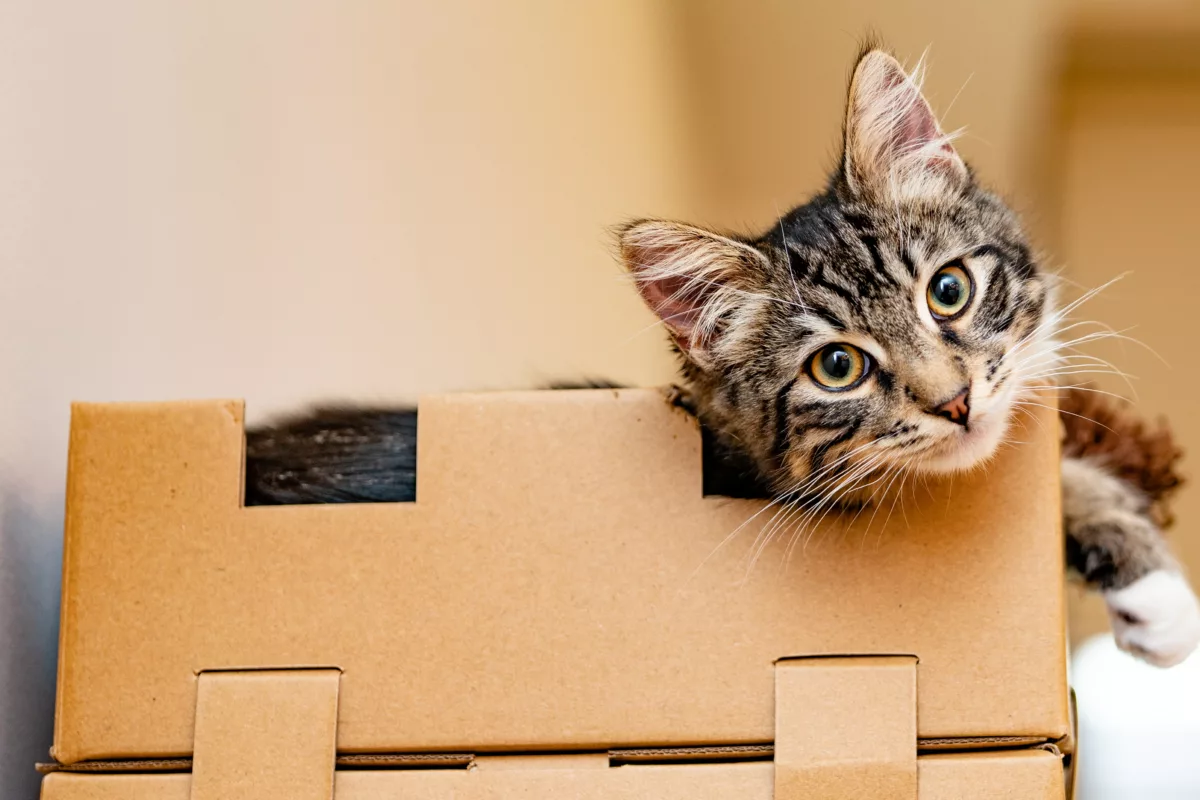Moving across the country with your cat?
Making an out-of-state move with your cat doesn’t have to be stressful, especially when you use a company like U-Pack®. We handle transporting your belongings so you can focus on traveling with your family and pets. Consult with your veterinarian about any health concerns you have for your feline friends and then try these tips to make the trip purr-fect.
Prepare your cat for the move
Cats are creatures of habit, and nothing can disrupt their routines quite like moving to a new home. Helping your cat prepare for the upcoming relocation will make the trip more pleasant for you and your purring companion.
Create a cozy cat space
Establish a room (or a large closet) as a temporary safe space for your cat where he can lounge and take his meals. Make the room comfortable by keeping his water, bed, toys and litter box there. This will be a place where your cat can stay isolated and calm while you’re packing and loading your things.
Get used to a crate
If your cat isn’t already used to traveling in a crate, don’t wait until moving day to introduce one. Start with keeping the crate open in the cat’s safe space and coax him into going inside with treats while leaving the door open. Later, allow your cat longer periods of time inside the crate to get comfortable with it and leave behind his scent.
Take short car rides
Your cat might only associate car rides with a trip to the vet, so it’s best to take shorter car rides prior to a long road trip. Gradually increase the duration of the rides to help your kitty get used to it. Offer plenty of praise and treats when the trips are over to help your cat associate the car with a positive experience.
Practice leash walking
You don’t usually walk your cat on a leash? It’s okay. While leash walking doesn’t come as naturally to cats as it does to most dogs, it can be done with some practice and patience. Start with getting him used to the harness and work your way up to using the leash in your yard or another safe space. You want to make sure your cat won’t dart away at any stops you make while driving to your new home.
Keep your kitty comfortable during the trip
An unhappy pet can make even a short car (or plane) trip stressful, so you’ll want a content cat for a long ride.
Confine your pet
It’s not safe to let your kitty roam the vehicle freely. Use a pet restraint, preferably a hard-shelled crate, to keep your cat contained in the car. If you’re flying to your new home, follow your airline’s recommendations for the proper crate or carrier. Make sure the carrier is secured and level in a seat with a vent pointing toward it for ventilation. If your cat is especially nervous in the car, try covering the crate with a thin blanket or towel to help him stay calm.
Pack essentials in the car
Whether it’s catnip or medication prescribed by your veterinarian, you’ll want to make sure your cat’s things are easily accessible in your car. Keep water, food, toys, pet waste bags and a portable litter box (you can pack extra litter in large zip-top bags) on-hand to make your kitty’s trip easier.
Plan feline-friendly rest stops
Pet stores are great places to stop for restroom breaks since you can take your cat inside with you.
Stay in cat-friendly hotels
Many hotels are listed as pet-friendly, but make sure to confirm that they’re not just dog-friendly. While you’ll need to check the rules at each location, these hotels are known to allow cats:
- Days Inn
- Extended Stay America
- Hotels by Hilton
- Marriott Hotels
- Motel 6
- Red Roof Inns
Help your cat adjust to a new home
Once you arrive at the new place, you’ll want to make your cat feel at home.
Make a new kitty hideaway
Remember that cozy cat space you created at the old place? Now’s the time to recreate it with the same items at your new home. Find a room or space for your cat with all his favorite things where he can relax while you set up your new household. As your cat becomes more comfortable, you can let him explore more of the home by moving a few of his things outside the safe space.
Keep cats indoors for two weeks to establish a routine
As territorial animals, cats have been known to try to return to previous homes. You don’t want to lose your friend, so most veterinarians recommend keeping cats inside for at least two weeks after a move. Supervise any outdoor visits or put him on a tether for brief time alone in the yard. Make sure your cat’s tags or microchip are updated with your new address in case he wanders off.

